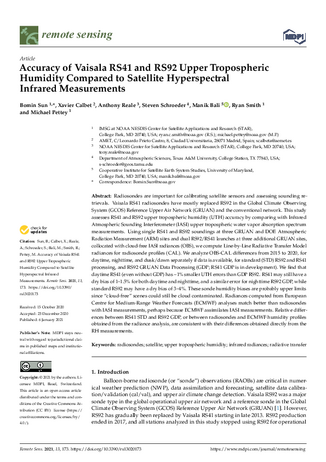Radiosondes are important for calibrating satellite sensors and assessing sounding retrievals. Vaisala RS41 radiosondes have mostly replaced RS92 in the Global Climate Observing System (GCOS) Reference Upper Air Network (GRUAN) and the conventional network. This study assesses RS41 and RS92 upper tropospheric humidity (UTH) accuracy by comparing with Infrared Atmospheric Sounding Interferometer (IASI) upper tropospheric water vapor absorption spectrum measurements. Using single RS41 and RS92 soundings at three GRUAN and DOE Atmospheric Radiation Measurement (ARM) sites and dual RS92/RS41 launches at three additional GRUAN sites, collocated with cloud-free IASI radiances (OBS), we compute Line-by-Line Radiative Transfer Model radiances for radiosonde profiles (CAL). We analyze OBS-CAL differences from 2015 to 2020, for daytime, nighttime, and dusk/dawn separately if data is available, for standard (STD) RS92 and RS41 processing, and RS92 GRUAN Data Processing (GDP; RS41 GDP is in development). We find that daytime RS41 (even without GDP) has ~1% smaller UTH errors than GDP RS92. RS41 may still have a dry bias of 1–1.5% for both daytime and nighttime, and a similar error for nighttime RS92 GDP, while standard RS92 may have a dry bias of 3–4%. These sonde humidity biases are probably upper limits since “cloud-free” scenes could still be cloud contaminated. Radiances computed from European Centre for Medium-Range Weather Forecasts (ECMWF) analyses match better than radiosondes with IASI measurements, perhaps because ECMWF assimilates IASI measurements. Relative differences between RS41 STD and RS92 GDP, or between radiosondes and ECMWF humidity profiles obtained from the radiance analysis, are consistent with their differences obtained directly from the RH measurements.
Title
Accuracy of Vaisala RS41 and RS92 Upper Tropospheric Humidity Compared to Satellite Hyperspectral Infrared Measurements
Authors
Sun, B.; Calbet, X.; Reale, A.; Schroeder, S.; Bali, M.; Smith, R.; Pettey, M.
Published
by Remote Sensing (RS) at 2021-01-06
Abstract
